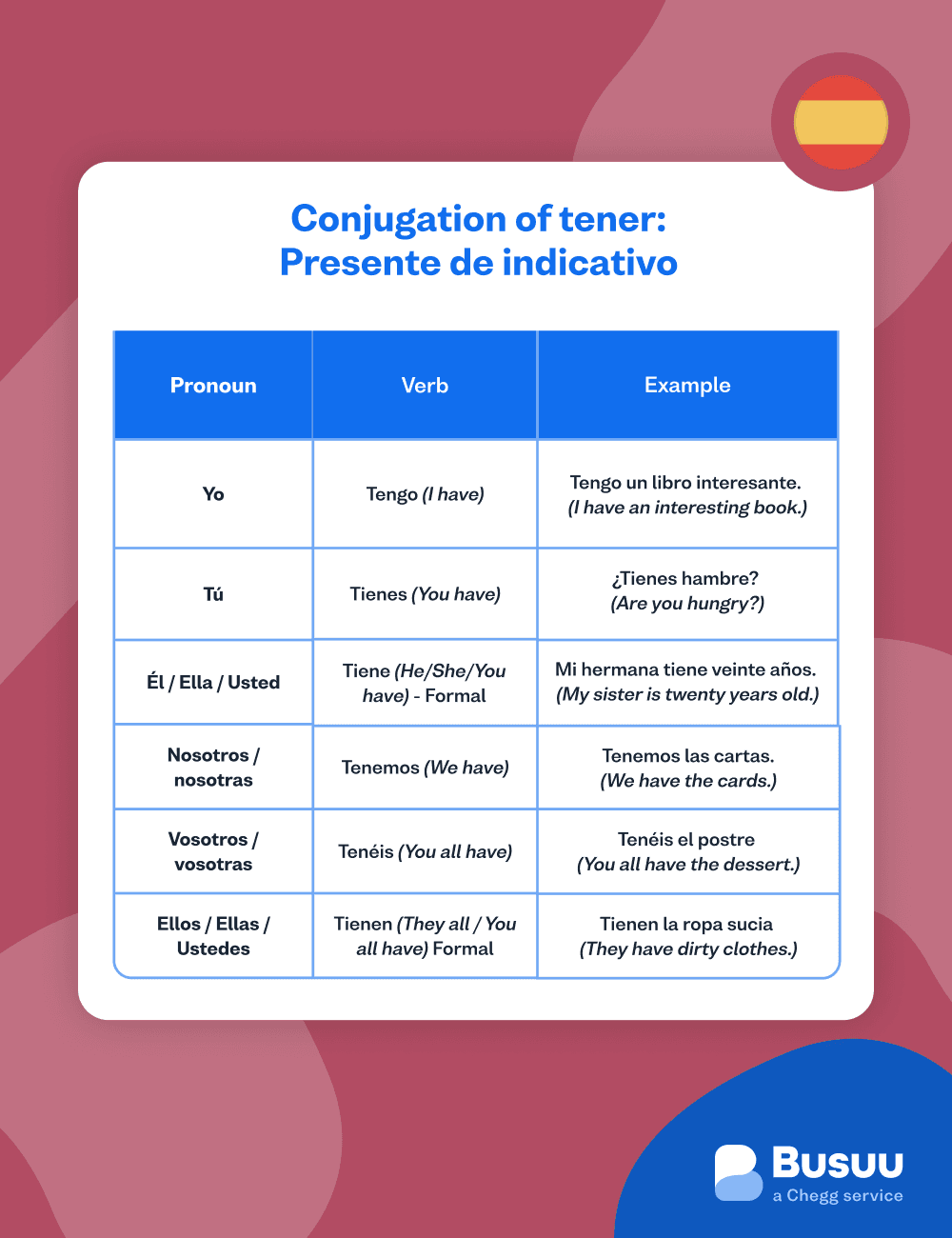I want to learn...
Tener is one of the most common Spanish verbs. It is used to express possession, indicating ownership of tangible and intangible objects. It is also used to convey various other meanings, including expressing age, expressing sensations or feelings, and forming idiomatic expressions such as 'tener miedo' (to be afraid) or 'tener ganas de' (to feel like/to want to do something).
As a basic-level Spanish student, gaining a comprehensive understanding of the verb “tener” and its three basic tenses —present, past, and future—will lay a solid foundation for your language journey.
Conjugation of the verb tener
The verb tener is an irregular verb in Spanish, which means that it does not follow regular conjugation patterns.
Present tense
The present tense of “tener” is used to express current possession or the existence of something at the present moment.
The present tense conjugation of the verb tener in Spanish follows a regular pattern for all pronouns except the first person singular (yo tengo), which is irregular. Apart from this irregularity, the present tense conjugation oftener shows a stem change from "e" to "ie" in the second and third person singular, as well as in all plural forms. This feature, shared with other Spanish verbs, is known as the "boot verb" because of the shape of its conjugation pattern.
Here is the conjugation of “tener” in the present tense:

Conjugation of tener: Presente de indicativo
| Pronoun | Verb | Example |
|---|---|---|
| Yo | Tengo (I have) | Tengo un libro interesante. (I have an interesting book.) |
| Tú | Tienes(You have) | ¿Tienes hambre? (Are you hungry?) |
| Él / Ella / Usted | Tiene (He/She/You - formal have) | Mi hermana tiene veinte años. (My sister is twenty years old.) |
| Nosotros / nosotras | Tenemos (We have) | Tenemos las cartas. (We have the cards.) |
| Vosotros / vosotras | Tenéis (You all have) | Tenéis el postre (You all have the dessert.) |
| Ellos / Ellas / Ustedes | Tienen (They all / You all - formal have) | Tienen la ropa sucia (They have dirty clothes.) |
Past tense
The past tense of “tener” is used to talk about past possessions or experiences. In Spanish, there are two common past tenses: the pretérito perfecto simple and the pretérito imperfecto.
Let's take a look at both of them:
1. Pretérito perfecto simple:This tense is used to express completed actions in the past. It is also known as pretérito indefinido.
2. Pretérito imperfecto:This tense is used to describe ongoing or repeated actions in the past.
Simple and imperfect past tense of tener
| Pronoun | Pretérito perfecto simple | Pretérito imperfecto |
|---|---|---|
| Yo | Tuve | Tenía |
| Tú | Tuviste | Tenías |
| Él / Ella / Usted | Tuvo | Tenía |
| Nosotros / nosotras | Tuvimos | Teníamos |
| Vosotros / vosotras | Tuvisteis | Teníais |
| Ellos / Ellas / Ustedes | Tuvieron | Tenían |
Examples:
Ayer tuve dolor de cabeza. (Yesterday, I had a headache.)
Tuviste un buen día de vacaciones. (You had a good vacation day.)
Mis abuelos tenían una casa en la playa. (My grandparents had a house at the beach.)
Future tense
The future tense of the verb tener is used to express possession in the future. Have a look at the table below:
Conjugation of the verb tener in the future tense
| Pronoun | Verb | Example |
|---|---|---|
| Yo | tendré | Yo tendré una casa en la playa. (I will have a house on the beach.) |
| Tú | tendrás | Tú tendrás muchos amigos. (You will have many friends.) |
| Él/Ella/Usted | tendrá | Él tendrá una fiesta mañana. (He will have a party tomorrow.) |
| Nosotros/Nosotras | tendremos | Nosotros tendremos una reunión. (We will have a meeting.) |
| Vosotros/Vosotras | tendréis | Vosotros tendréis éxito en el proyecto. (You all will have success in the project.) |
| Ellos/Ellas/Ustedes | tendrán | Ellos tendrán nuevas oportunidades. (They will have new opportunities.) |
Common expressions with the verb tener
Apart from its basic meaning of possession, “tener” is also used in several idiomatic expressions.
For example:
“Tener hambre” means “to be hungry.”
“Tener sed” means“to be thirsty.”
“Tener frío/calor” means “to be cold/hot.”
The verbteneris often used in combination with other verbs to express different actions and states:
“Tener que” means “to have to,” indicating obligation or necessity.
While “tener ganas de” means “to feel like” or “to want to.”
Understanding the basic concepts of the verb tener and its three basic tenses - present, past and future - will enable you to communicate effectively in different situations.
Remember to practice conjugating “tener” and incorporate it into your conversations to reinforce your understanding of its usage.
With time and practice, you will become more proficient in using “tener” and its nuances in the Spanish language.
Newlanguages


